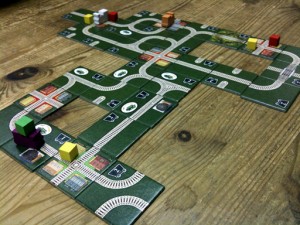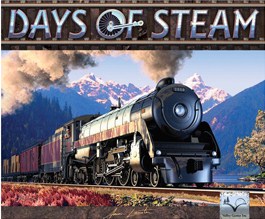Review: Days of Steam
Posted by James (admin) on February 18th, 2011
 Days of Steam is a light, train-themed, tile-laying game. The tiles show different track routes (or towns) which build up to create a rail network between towns.
Days of Steam is a light, train-themed, tile-laying game. The tiles show different track routes (or towns) which build up to create a rail network between towns.
Each player has 1 train and scores victory points (VPs) by delivering goods and completing circuits. The winner is the first player to score 13 VPs, or the one with the most VPs when the tiles run out. Each turn a player can either move their train (costing 1 point of steam per tile), play a track tile from their hand (earning 1 – 2 steam), play a town tile, or use a water tower (earning 4 steam).
Tiles played either extend the railway lines or add a town to the network. Each town starts with 2 random colour goods on it which can be picked up by players (carrying 1 at a time). Players score 2 VP for delivering a good to a matching coloured town and there are bonus VPs for having delivered different colours of goods. If a player places track that creates a ‘circuit’ – a route that goes from a town through another town and back without using any tile twice – they score 1VP. The rules on tile placement are clear and ensure there isn’t too much or too little space between towns. A few tiles allow players to replace an existing tile.
When a player moves their train, it costs 1 point of steam per tile and they can store a maximum of 6 steam at any time. If a player travels quickly (using 3 steam or more in their turn), they must make a dice roll for every corner they go round to check if they crash – the faster they are going, the more likely they’ll crash. If they crash, they simply return to where they started their move but their turn is over.
 Overall, Days of Steam is a light game. There’s an element of racing to grab the goods and to make as much progress each move as you can. You’re always trying to lay track that helps you more than it will help your opponents, plus you need to decide on how much to push your luck when going fast around corners. As only 1 train can end on a non-town tile, there is a little bit of tactical play in positioning your train too.
Overall, Days of Steam is a light game. There’s an element of racing to grab the goods and to make as much progress each move as you can. You’re always trying to lay track that helps you more than it will help your opponents, plus you need to decide on how much to push your luck when going fast around corners. As only 1 train can end on a non-town tile, there is a little bit of tactical play in positioning your train too.
The limited choices each turn keep the game flowing and you’re usually planning a few steps ahead which has a nice feeling that you are in control and can play tactically. As track placement and grabbing goods affects other player, the game has good interaction and adds the tension that your plans are often under threat.
The game plays 3 – 5 players and I think it will play best with 4 or 5. In our 3-player game, two players were in one area of the board (competing over the goods and laying tiles to annoy each other) whilst I roamed a different area and was able to win quickly without being hindered. With more players, I think this would be less likely to occur.
Luck plays a part in two main areas. The luck of the dice roll for corners can be harsh, although at least you know your odds before attempting a move. Also, there is also luck involved in the tiles you draw – it’s good you have 3 to pick from but this can still leave you without much choice. The luck factor in the tile draw seems okay (although I’d like an option to use my turn to replace my entire hand). However, as someone who doesn’t like too much luck in my games, the cornering dice roll can be too harsh if someone consistently rolls unluckily. To address this, I wondered if each failed attempt should give you +1 for your next roll if you attempt the same route again to limit the effects of extended bad luck.
The VPs scored for creating circuits seem to exist to encourage creating loops which make movement more interesting; however, players trying to create a circuit often hand 1 VP to an opponent who happens to have a tile that can fill in the last piece before they have a chance to do so themselves. So, the gameplay is to try and make a circuit no-one has spotted or requires a less common tile to complete it.
The cornering dice roll is simple enough but the maths is slightly fiddly. A custom dice would have been useful to make this even easier (showing -/-/3+/4+/5+/6+ and players would crash if they rolled their total steam spent).
Visually the game looks nice but fairly basic. The plain green background of the track tiles is a bit boring and it would have been more appealing and exciting if the tiles had landscaped backgrounds which wouldn’t compromise clarity.
If played as a light game, Days of Steam is fun and plays quickly. If you want games that are more meaty, or have zer0-luck, then this probably isn’t for you. The locomotive expansion sounds like it would add a bit more meat to the game so I’d like to play with that next time.
James.
[Played with 3 players]

